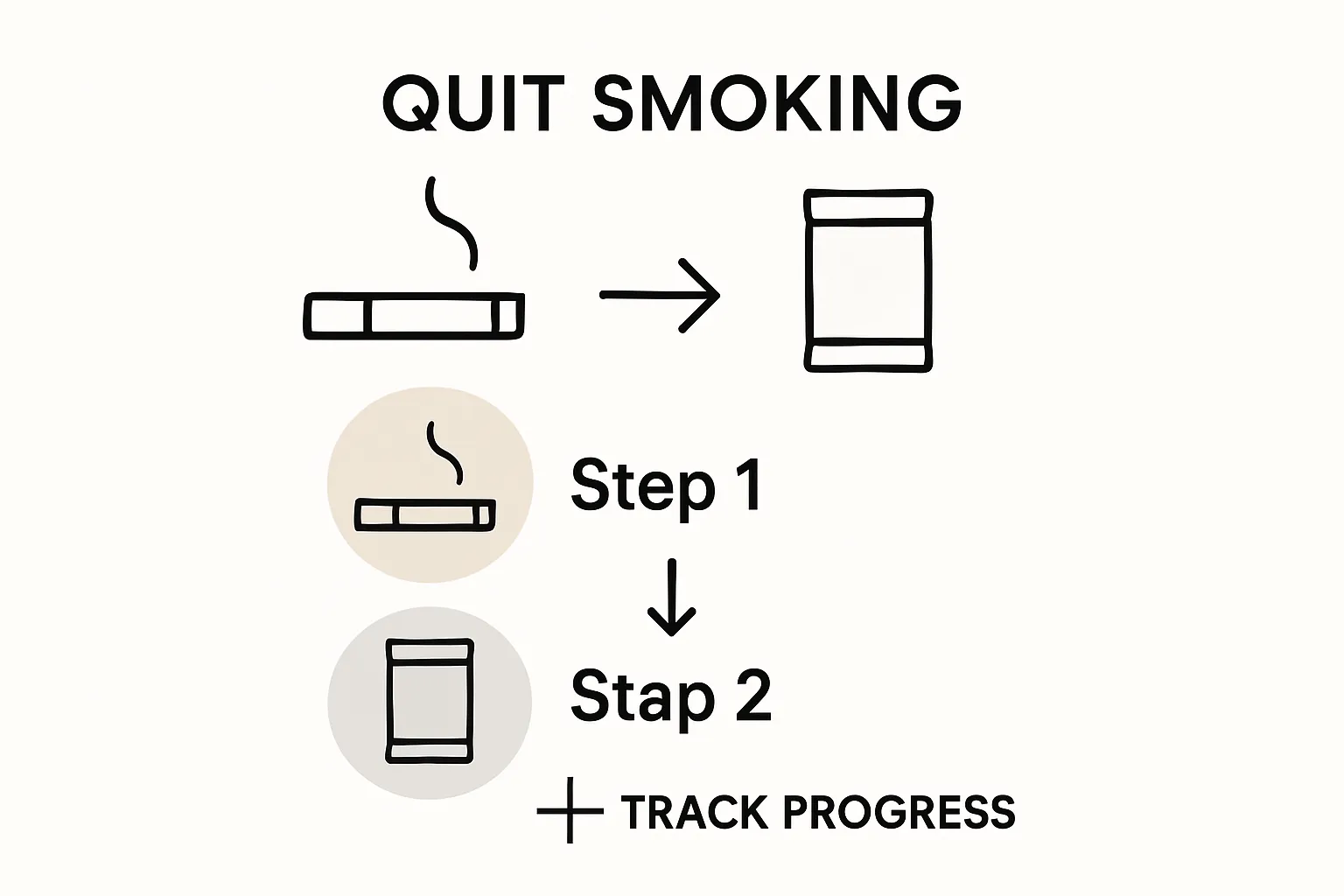Uncategorized
Transition to Smokeless Nicotine: A Step-by-Step Guide
Switching from smoking or vaping to smokeless nicotine is more than a trend. Nearly 15 million Americans now use alternative nicotine products every month. Most people imagine this change is simple and painless. Reality looks different. Finding the right smokeless option actually demands a step-by-step plan that transforms guesswork into lasting comfort.
Table of Contents
- Step 1: Assess Your Current Nicotine Use
- Step 2: Research Available Smokeless Products
- Step 3: Choose The Right Smokeless Option For You
- Step 4: Create A Switching Plan And Timeline
- Step 5: Test And Adjust Your Usage For Comfort
- Step 6: Monitor Your Progress And Make Adjustments
Quick Summary
| Key Point | Explanation |
|---|---|
| 1. Assess Your Current Nicotine Use | Understand and document your nicotine consumption patterns to guide your transition strategy effectively. |
| 2. Research Available Smokeless Products | Explore various smokeless nicotine options, focusing on their strengths, features, and health implications to find the best fit. |
| 3. Choose the Right Smokeless Option | Select a product that matches your nicotine needs and lifestyle preferences for a smoother transition experience. |
| 4. Create a Switching Plan and Timeline | Develop a structured plan with realistic timelines to reduce dependence while comfortably incorporating smokeless nicotine. |
| 5. Monitor Your Progress and Make Adjustments | Regularly track your experience and stay flexible, making necessary adjustments to enhance your transition process. |
Step 1: Assess Your Current Nicotine Use
Transitioning to smokeless nicotine begins with understanding your current nicotine consumption and dependency. This critical first step helps you create a personalized and effective transition strategy that matches your individual needs and habits.
Start by tracking your current nicotine intake with precision and honesty. For traditional smokers, this means documenting how many cigarettes you consume daily. Vape users should note the nicotine strength of their e-liquids and frequency of use. Tracking involves more than just counting numbers – it requires understanding your consumption patterns, triggers, and emotional connections to nicotine.
To conduct a comprehensive self-assessment, consider utilizing a structured approach recommended by addiction specialists. Nicotine dependency assessment tools can provide objective insights into your current usage. These tools help you quantify your nicotine dependence beyond simple consumption metrics, examining psychological and physiological aspects of your nicotine relationship.
Key elements to document during your assessment include:
- Total daily nicotine consumption
- Times of day when nicotine cravings are strongest
- Emotional or situational triggers that prompt nicotine use
- Current nicotine delivery methods
- Perceived stress levels related to potential reduction
Through our official nicotine replacement guide, you can find additional resources to support this assessment process. The goal is creating a transparent, judgment-free overview of your current nicotine consumption that will serve as the foundation for a successful transition strategy.
This checklist summarizes core elements to document during your initial nicotine use assessment, helping you track and understand your habits thoroughly.
| Assessment Element | Description |
|---|---|
| Total Daily Use | Record total cigarettes, vape sessions, or milligrams of nicotine consumed |
| Craving Times | Identify times of day when cravings are strongest |
| Triggers | Note emotional or situational triggers for nicotine use |
| Current Methods | Document nicotine delivery methods currently used |
| Stress Level | Track perceived stress related to reducing nicotine |
Successful assessment means developing a clear, honest picture of your current nicotine use without self-criticism. This data becomes your roadmap for the subsequent steps in your smokeless nicotine transition journey, enabling more targeted and personalized approach to reducing dependency.
Step 2: Research Available Smokeless Products
Researching smokeless nicotine products represents a pivotal moment in your transition strategy. This step transforms your assessment data into actionable insights, helping you identify the most suitable alternatives that align with your nicotine consumption patterns and personal preferences.
Comprehensive product research requires a systematic approach. Begin by exploring different categories of smokeless nicotine delivery systems, understanding their unique characteristics, nicotine absorption rates, and potential health implications. Modern smokeless nicotine products encompass a diverse range of options including nicotine pouches, snus, lozenges, and oral nicotine strips.
Dive deep into product specifications by examining ingredient lists, nicotine concentration levels, and manufacturing standards. Pay close attention to factors like discretion, convenience, flavor profiles, and nicotine release mechanisms. Each product category offers distinct advantages: pouches provide subtle usage, lozenges offer controlled dosage, and oral strips ensure rapid absorption.
Key research considerations include:
- Nicotine strength compatibility with your current consumption
- Product accessibility and legal regulations
- User reviews and community feedback
- Potential side effects and health considerations
- Cost effectiveness compared to current nicotine delivery methods
To support your research journey, explore our comprehensive product lineup for expert insights and detailed information. The goal is not just finding a replacement, but discovering a smokeless nicotine solution that seamlessly integrates into your lifestyle.

Successful research means developing a nuanced understanding of available smokeless products, enabling you to make an informed decision that supports your transition goals. By methodically evaluating options, you transform potential uncertainty into a confident, strategic pathway toward smokeless nicotine consumption.
Below is a comparison table to help you evaluate different types of smokeless nicotine products mentioned in the article and how they align with user needs.
| Product Type | Strengths | Nicotine Release | Convenience | Health Considerations |
|---|---|---|---|---|
| Nicotine Pouches | Discreet, subtle usage | Moderate | High | Fewer oral irritants |
| Snus | Strong, steady release | Slow-Moderate | Moderate | Higher salt content |
| Lozenges | Controlled dosage | Slow | Moderate | May cause occasional nausea |
| Oral Nicotine Strips | Rapid absorption | Fast | Very high | Mild oral irritation possible |
Step 3: Choose the Right Smokeless Option for You
Choosing the right smokeless nicotine product is a deeply personal decision that requires careful consideration of your unique needs, lifestyle, and nicotine consumption patterns. This step transforms your research into a targeted selection process that maximizes your potential for a successful transition.
Matching your nicotine requirements with the most appropriate product is crucial. User preferences and satisfaction significantly impact switching success, so prioritize products that align closely with your current consumption habits and personal comfort level. Consider factors like discretion, ease of use, flavor preferences, and nicotine strength that will make your transition smooth and sustainable.
Begin by cross-referencing your initial nicotine assessment with the product specifications you discovered during your research. If you were a heavy smoker consuming multiple cigarettes daily, you might require a higher nicotine strength product. Conversely, lighter users can opt for lower concentration options that provide a more gradual reduction.
Key selection criteria include:
- Compatibility with your current nicotine intake
- Comfort and discretion of product usage
- Flavor and sensory preferences
- Potential health considerations
- Budget and long-term affordability
Explore our smooth tobacco options to find a product that resonates with your specific needs. The ideal smokeless nicotine product should feel like a natural extension of your current routine, not a jarring replacement.
Successful selection means finding a product that not only meets your nicotine requirements but also provides a satisfying experience that supports your transition goals. Trust your research, listen to your body, and remain open to adjusting your choice as you progress through your smokeless nicotine journey.
Step 4: Create a Switching Plan and Timeline
Transitioning to smokeless nicotine requires more than good intentions. A structured, personalized switching plan transforms your goals into actionable steps, providing a clear roadmap that increases your likelihood of successfully changing nicotine delivery methods.
Structured planning significantly improves transition success rates, making this step critical to your journey. Begin by establishing a realistic timeline that considers your current nicotine consumption, personal commitments, and psychological readiness. Your plan should include gradual reduction strategies, allowing your body and mind to adapt smoothly to the new nicotine delivery system.
Consider creating a phased approach that allows flexibility while maintaining consistent progress. Start by introducing your chosen smokeless product alongside your current nicotine method, gradually reducing traditional consumption. This approach minimizes potential withdrawal symptoms and provides a psychological safety net during the transition.

Key timeline planning components include:
- Initial introduction period for the new smokeless product
- Scheduled reduction of previous nicotine delivery method
- Contingency strategies for managing potential cravings
- Regular self-assessment checkpoints
- Reward milestones for successful progression
Document your plan in a format that feels comfortable and accessible. Some individuals prefer digital tracking apps, while others might find a physical journal more motivating. The goal is creating a personalized strategy that feels supportive rather than restrictive.
Successful timeline creation means developing a flexible, compassionate plan that acknowledges your individual journey. Remember that progress is not linear, and minor setbacks are normal. Your switching plan is a living document that can be adjusted as you learn more about your nicotine transition needs.
Step 5: Test and Adjust Your Usage for Comfort
Transitioning to smokeless nicotine is a nuanced process that requires patience, self-awareness, and a willingness to adapt. Your initial choice is not a permanent commitment, but rather the beginning of a personalized exploration toward finding the most comfortable and satisfying nicotine delivery method.
Monitoring side effects and adjusting dosage are crucial for successful transition, making this testing phase fundamental to your journey. Begin by implementing your chosen smokeless product systematically, paying close attention to your body’s response, comfort level, and overall satisfaction. Notice subtle changes in nicotine absorption, potential oral sensitivities, and how the new product integrates with your daily routine.
Document your experience meticulously. Track factors like timing of usage, duration of nicotine satisfaction, any emerging side effects, and your emotional state during the transition. This detailed record becomes your personal roadmap, helping you make informed adjustments. Some individuals might require multiple product iterations before finding their ideal smokeless nicotine solution.
Key areas to evaluate during your testing phase include:
- Nicotine absorption rate and satisfaction level
- Potential oral or physical side effects
- Convenience and discretion of product usage
- Psychological comfort and stress management
- Consistency of nicotine delivery
Remain flexible and compassionate with yourself throughout this process. Switching nicotine delivery methods is a significant change that requires time, experimentation, and self-understanding. Some discomfort is normal, but persistent issues might indicate a need to reassess your product selection or nicotine strength.
Successful testing means developing a nuanced understanding of how smokeless nicotine products interact with your unique physiology and lifestyle. Trust the process, remain observant, and be prepared to make thoughtful adjustments that support your overall well-being.
Step 6: Monitor Your Progress and Make Adjustments
Transitioning to smokeless nicotine is a dynamic journey that requires ongoing attention, self-reflection, and strategic adaptability. Progress is not a linear path, but a personalized exploration that demands continuous monitoring and thoughtful recalibration of your approach.
Behavioral support and strategic reassessment significantly improve long-term transition success, making this step critical to your smokeless nicotine journey. Develop a comprehensive tracking system that goes beyond simple consumption metrics. Create a holistic progress journal that captures physical, emotional, and psychological dimensions of your transition.
Establish regular check-in intervals to evaluate your smokeless nicotine experience objectively. These assessments should include a thorough examination of your initial goals, current satisfaction levels, and any emerging challenges. Be prepared to make nuanced adjustments to your nicotine strength, product type, or consumption frequency based on your observations.
Key progress monitoring elements include:
- Physical symptoms and potential side effects
- Emotional well-being and stress management
- Consistency with your original transition plan
- Financial impact of your new nicotine approach
- Overall quality of life improvements
Approach these monitoring sessions with curiosity and compassion. Recognize that each adjustment is a step toward understanding your unique nicotine relationship. Some transitions might require multiple iterations, and that’s a normal part of the process. Your goal is not perfection, but progressive improvement and personal wellness.
Successful progress monitoring means developing a flexible, responsive approach to your smokeless nicotine transition. By remaining observant, honest, and willing to adapt, you transform this journey from a simple product switch into a comprehensive personal growth experience.
Ready to Make Your Smokeless Nicotine Transition Easier?
You have taken the time to learn, assess, and strategize a path toward smokeless nicotine. Maybe you are overwhelmed by product choices, unsure how to match your personal needs, or struggling to build long-term comfort and confidence with your switch. Most people face challenges like finding reliable, compliant products or wanting guidance to avoid setbacks. You do not have to figure it all out on your own. Visit our Uncategorized product collection to see innovative smokeless options and proven solutions, all tailored for different preferences and lifestyles.

Make today the day you act. Explore Official Alibarbar for the latest high-quality nicotine alternatives, industry-leading safety, and practical resources to help you succeed at every step. Take control of your transition with products and support trusted by users and retailers worldwide. Your smoother journey starts here.
Frequently Asked Questions
What steps should I take to assess my current nicotine use?
To assess your current nicotine use, track your daily consumption of cigarettes or vape, identify your cravings and triggers, and document your emotional connections to nicotine. Consider using nicotine dependency assessment tools for a comprehensive overview of your habits.
How do I choose the right smokeless nicotine product for my needs?
Choose the right smokeless nicotine product by matching your nicotine requirements with options that fit your consumption patterns. Consider factors like nicotine strength, convenience, flavor preferences, and overall comfort. Research various product categories like nicotine pouches, lozenges, and strips to find what suits you best.
What should I include in my switching plan and timeline for transitioning to smokeless nicotine?
Your switching plan should include a realistic timeline, gradual reduction strategies, and scheduled checkpoints for self-assessment. Document the introduction of the new product, reduction of previous methods, and any contingency plans for cravings.
How can I monitor my progress and adjust my approach during the transition?
To monitor your progress, create a holistic progress journal that captures your physical, emotional, and psychological experiences during the transition. Conduct regular check-ins to evaluate your satisfaction levels and challenges, and make informed adjustments to your nicotine strength and product choice as needed.
Recommended
- Smooth Tobacco – Official Alibarbar
- Alibarbar Nicotine Gum – Official Alibarbar
- Alibarbar Nicotine Pouches – Official Alibarbar
Article generated by BabyLoveGrowth

